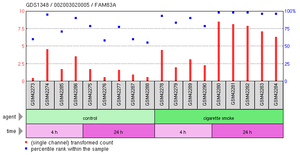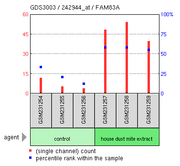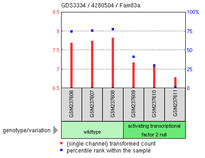FAM83A
Protein FAM83A (family member with sequence similarity 83) also known as tumor antigen BJ-TSA-9 is a protein that in humans is encoded by the FAM83A gene.[4]
| FAM83A | |||||||||||||||||||||||||
|---|---|---|---|---|---|---|---|---|---|---|---|---|---|---|---|---|---|---|---|---|---|---|---|---|---|
| |||||||||||||||||||||||||
| Identifiers | |||||||||||||||||||||||||
| Aliases | FAM83A, BJ-TSA-9, family with sequence similarity 83 member A | ||||||||||||||||||||||||
| External IDs | MGI: 2447773 HomoloGene: 13158 GeneCards: FAM83A | ||||||||||||||||||||||||
| |||||||||||||||||||||||||
| |||||||||||||||||||||||||
| Orthologs | |||||||||||||||||||||||||
| Species | Human | Mouse | |||||||||||||||||||||||
| Entrez | |||||||||||||||||||||||||
| Ensembl |
| ||||||||||||||||||||||||
| UniProt | |||||||||||||||||||||||||
| RefSeq (mRNA) | |||||||||||||||||||||||||
| RefSeq (protein) | |||||||||||||||||||||||||
| Location (UCSC) | Chr 8: 123.18 – 123.21 Mb | n/a | |||||||||||||||||||||||
| PubMed search | [2] | [3] | |||||||||||||||||||||||
| Wikidata | |||||||||||||||||||||||||
| |||||||||||||||||||||||||
This protein is predicted to contain one domain of unknown function 1669 (DUF1669), which places this protein into the PLDc_SuperFamily.[4][5][6] It has been linked to be a potential biomarker in lung, prostate, and bladder cancers.[7][8][9]
Gene
FAM83A is located on chromosome 8, locus q24.13,[4] and spans 27,566 base pairs.[4] There is a promoter approximately 4,000 base pairs upstream as predicted by the tool ElDorado by Genomatix.[10] Deletions in this part of the chromosome, including the FAM83A gene, often result in Langer-Giedion syndrome.[11]
mRNA
The FAM83A mRNA has 10 different splice forms,[12] with transcript variant 1 being the subject of this article. This mRNA consists of approximately 2,900 base pairs. It contains a domain of unknown function 1669 (DUF1669), and is a member of the PLDc_SF superfamily.[13] It has been placed into this superfamily based on highly similar sequences between FAM83A and other N-terminus phospholipase D-like domains; however, it's missing the functional histidine and therefore only predicted to have a similar structure.[6] Four exons comprise this mRNA.[4][14] Predictions show several possible RNA stem loop formations in the untranslated regions of the mRNA.[15]

Protein
The FAM83A gene encodes for the FAM83A protein isoform A.[4] This protein is 434 amino acids in length, and weighs approximately 45 kiloDaltons.[16] Although the structure is not confirmed, it is predicted using GOR4 to have four alpha helices and five beta sheets,[17] with an isoelectric point of 8.964[15] There appears to be no signal peptide[18] and is not a transmembrane protein.[19] Using CBLAST, it was observed to share a common sequence with the protein 3H0G,[20] however, not in the predicted functional region of FAM83A. This may still provide valuable information, though, on a possible partial structure for this protein.
Expression
FAM83A is expressed in many different areas of the human body, and at very different levels.[21] EST data suggests that this gene is expressed primarily in adults. It shows significant levels in the mouth and larynx, with other raised expression in the prostate, lung, and esophagus.[21] These normal levels are even more elevated in head and neck tumors, lung tumors, prostate cancers, and bladder carcinomas.[21] Microarray expression data also show different environmental conditions, especially irritants. Such irritants can be cigarette smoke, where FAM83A has been shown to increase expression after 24 hours exposure,[22] and house dust mite extract on bronchial epithelial cells, where FAM83A expression also increases after exposure.[23] FAM83A shows decreased expression when activating transcription factor 2 (ATF2) is knocked out.[24] Since ATF2 was not predicted to bind in the promoter region, it suggests that there is an indirect relationship between FAM83A and ATF2. With increased expression to irritants and allergens along with an indirect relationship with ATF2, it suggests FAM83A may be in a signaling pathway.



Cancer
There are multiple studies that link FAM83A overexpression to lung, prostate, and bladder cancers. Researchers believe that this gene might make a good candidate for early detection of these cancers, especially lung cancer.[7][8] It is unknown why or how FAM83A is upregulated. Studies have shown that arsenic can acetylate the promoter causing upregulation, suggesting this may be a similar mechanism to how this gene becomes unregulated in cancer.[9]
Protein interaction
FAM83A has been shown to interact with palate, lung, and nasal epithelium carcinoma associated protein (PLUNC) through the STRING tool.[25] This information gathered came from textmining information dealing with cancer.[8]
Homology
FAM83A appears to be a relatively new gene, with BLAST and BLAT only showing orthology back through bony fishes.[14][26] It is highly conserved through its relatives[26] The DUF1669 domain is the most highly conserved region of the protein, with areas outside of it being more variable. Below is a table of orthologs, noting that this is not a comprehensive list:
| Genus Species | Organism Common Name | Divergence from Humans (MYA) [27] | NCBI Protein Accession Number | Sequence Identity | Protein Length |
|---|---|---|---|---|---|
| Homo sapiens | Humans | -- | NM_032899.4[16] | 100% | 434 |
| Pan troglodytes | Chimpanzee | 6.2 | XP_001147312.2[28] | 99% | 434 |
| Bos taurus | Cattle | 97.4 | XP_599662.2[29] | 89% | 435 |
| Canis lupus | Dog | 97.4 | XP_851601.2[30] | 89% | 435 |
| Mus musculus | Mouse | 91 | NP_776287.2[31] | 87% | 436 |
| Anolis carolinensis | Lizard | 324.5 | XP_003228186.1[32] | 70% | 438 |
| Gallus gallus | Chicken | 324.5 | XP_001233861.2[33] | 69% | 439 |
| Xenopus laevis | Frog | 361.2 | NP_001079963.1[34] | 64% | 443 |
| Danio rerio | Zebrafish | 454.6 | XP_001340276.3[35] | 59% | 426 |
References
- GRCh38: Ensembl release 89: ENSG00000147689 - Ensembl, May 2017
- "Human PubMed Reference:". National Center for Biotechnology Information, U.S. National Library of Medicine.
- "Mouse PubMed Reference:". National Center for Biotechnology Information, U.S. National Library of Medicine.
- "Entrez Gene, FAM83A". NCBI. Retrieved 2012-04-22.
- "PLDc_SF". NCBI.
- "FAM83A, PLDc_SF categorization". NCBI.
- Liu L, Liao GQ, He P, Zhu H, Liu PH, Qu YM, Song XM, Xu QW, Gao Q, Zhang Y, Chen WF, Yin YH (August 2008). "Detection of circulating cancer cells in lung cancer patients with a panel of marker genes". Biochem. Biophys. Res. Commun. 372 (4): 756–60. doi:10.1016/j.bbrc.2008.05.101. PMID 18514066.
- Li Y, Dong X, Yin Y, Su Y, Xu Q, Zhang Y, Pang X, Zhang Y, Chen W (December 2005). "BJ-TSA-9, a novel human tumor-specific gene, has potential as a biomarker of lung cancer". Neoplasia. 7 (12): 1073–80. doi:10.1593/neo.05406. PMC 1501171. PMID 16354590.
- Jensen TJ, Wozniak RJ, Eblin KE, Wnek SM, Gandolfi AJ, Futscher BW (February 2009). "Epigenetic mediated transcriptional activation of WNT5A participates in arsenical-associated malignant transformation". Toxicol. Appl. Pharmacol. 235 (1): 39–46. doi:10.1016/j.taap.2008.10.013. PMC 4438681. PMID 19061910.
- "Genomatix, ElDorado". Genomatix. Retrieved 2012-04-26.
- Pereza N, Severinski S, Ostojić S, Volk M, Maver A, Dekanić KB, Kapović M, Peterlin B (March 2012). "Third case of 8q23.3-q24.13 deletion in a patient with Langer-Giedion syndrome phenotype without TRPS1 gene deletion". Am. J. Med. Genet. A. 158A (3): 659–63. doi:10.1002/ajmg.a.35201. PMID 22315192.
- "Ensembl, FAM83A". Retrieved 2012-04-26.
- "Entrez, PLDc_SuperFamily". NCBI. Retrieved 2012-04-22.
- Kent WJ (April 2002). "BLAT--the BLAST-like alignment tool". Genome Res. 12 (4): 656–64. doi:10.1101/gr.229202. PMC 187518. PMID 11932250.
- "Biology Workbench". San Diego Supercomputer.
- "GenPept, FAM83A". NCBI. Retrieved 2012-04-26.
- Sen TZ, Jernigan RL, Garnier J, Kloczkowski A (June 2005). "GOR V server for protein secondary structure prediction". Bioinformatics. 21 (11): 2787–8. doi:10.1093/bioinformatics/bti408. PMC 2553678. PMID 15797907.
- Petersen TN, Brunak S, von Heijne G, Nielsen H (2011). "SignalP 4.0: discriminating signal peptides from transmembrane regions". Nat. Methods. 8 (10): 785–6. doi:10.1038/nmeth.1701. PMID 21959131.
- Krogh A, Larsson B, von Heijne G, Sonnhammer EL (January 2001). "Predicting transmembrane protein topology with a hidden Markov model: application to complete genomes". J. Mol. Biol. 305 (3): 567–80. doi:10.1006/jmbi.2000.4315. PMID 11152613.
- "CBLAST". NCBI. Retrieved 2012-04-26.
- "EST Profiles, FAM83A". NCBI.
- "GDS1348, FAM83A expression to cigarette smoke". NCBI.
- Vroling AB, Duinsbergen D, Fokkens WJ, van Drunen CM (November 2007). "Allergen induced gene expression of airway epithelial cells shows a possible role for TNF-alpha". Allergy. 62 (11): 1310–9. doi:10.1111/j.1398-9995.2007.01495.x. PMID 17919147.
- Bhoumik A, Fichtman B, Derossi C, Breitwieser W, Kluger HM, Davis S, Subtil A, Meltzer P, Krajewski S, Jones N, Ronai Z (February 2008). "Suppressor role of activating transcription factor 2 (ATF2) in skin cancer". Proc. Natl. Acad. Sci. U.S.A. 105 (5): 1674–9. Bibcode:2008PNAS..105.1674B. doi:10.1073/pnas.0706057105. PMC 2234203. PMID 18227516.
- Szklarczyk D, Franceschini A, Kuhn M, Simonovic M, Roth A, Minguez P, Doerks T, Stark M, Muller J, Bork P, Jensen LJ, von Mering C (January 2011). "The STRING database in 2011: functional interaction networks of proteins, globally integrated and scored". Nucleic Acids Res. 39 (Database issue): D561–8. doi:10.1093/nar/gkq973. PMC 3013807. PMID 21045058.
- "BLAST". NCBI. Retrieved 2012-04-22.
- "Time Tree".
- "NCBI Nucleotide: XP_001147312.2".
- "NCBI Nucleotide: XP_599662.2".
- "NCBI Nucleotide: XP_851601.2".
- "NCBI Nucleotide: NP_776287.2".
- "NCBI Nucleotide: XP_003228186.1".
- "NCBI Nucleotide: XP_001233861.2".
- "NCBI Nucleotide: NP_001079963.1".
- "NCBI Nucleotide: XP_001340276.3".

